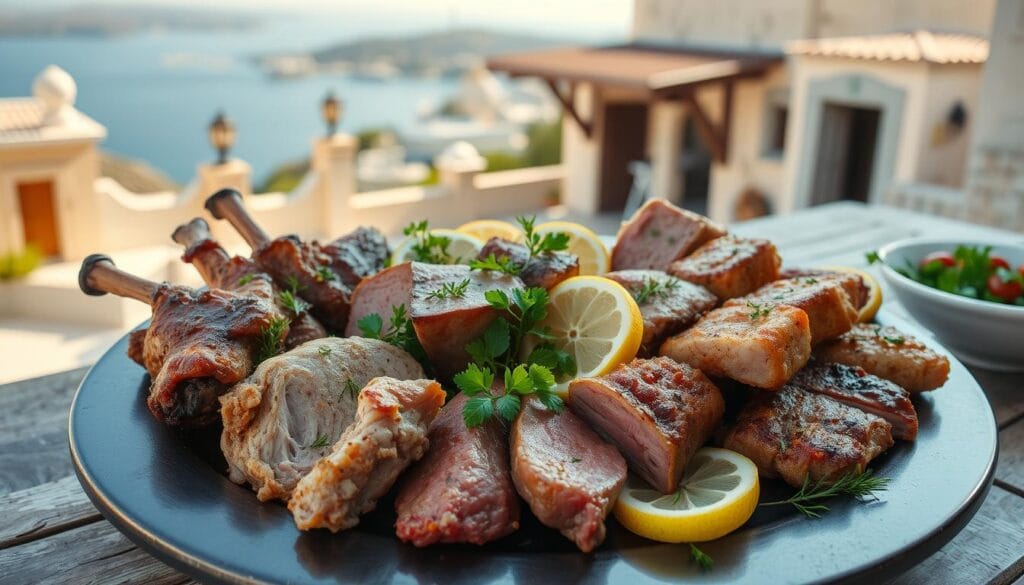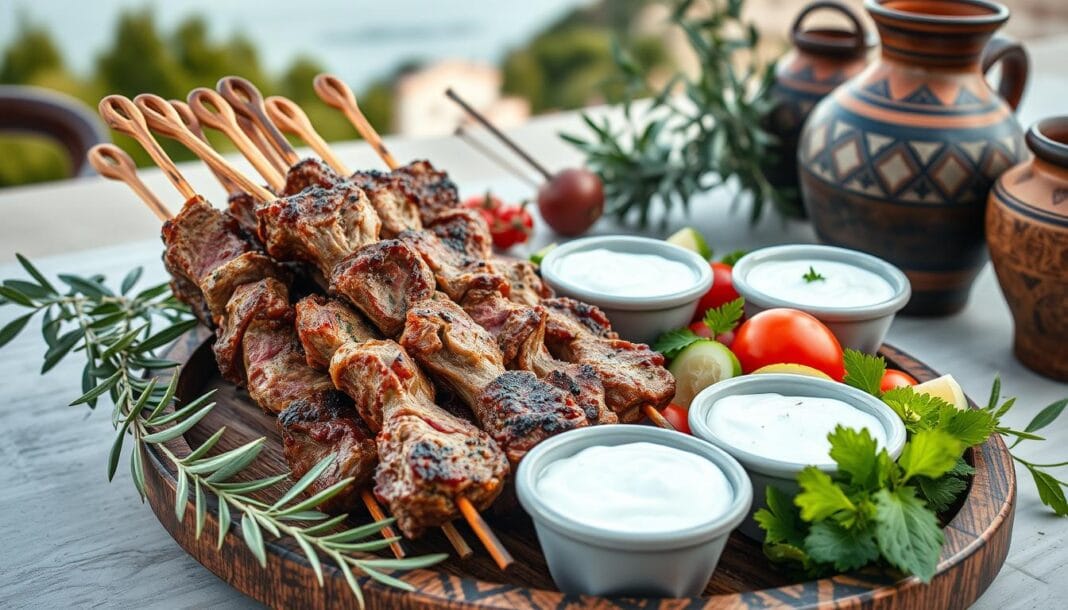Thinking of Greece makes me think of its delicious food. Lamb is a big hit, loved for its taste and how it’s used in many dishes. Greek food is full of meat dishes that show off the country’s traditions and culture.
Pork, chicken, goat, and beef are also key players in Greek cuisine. Each brings its own taste and texture, making Greek food so lively. Exploring Greek food, I see how important these meats are, especially at big family events123.
Key Takeaways
- Lamb is widely regarded as Greece’s most popular meat, favored for its flavor and preparation versatility.
- Pork, especially in dishes like souvlaki, plays a central role in family gatherings, showcasing its popularity.
- Chicken is a staple in various comforting recipes, including Avgolemono, a traditional chicken soup.
- Goat meat is appreciated for its lean qualities and is often featured in celebratory meals.
- Beef also has its place in Greek cuisine, appearing in cozy dishes like Kokkinisto, a hearty beef stew.
Introduction to Greek Cuisine

Greek cuisine is a vibrant mix of fresh ingredients and bold flavors. It’s known for its rich history and variety of dishes like Moussaka and Souvlaki. Greek meals are all about sharing and enjoying food together, showing the warm hospitality of Greek culture.
Lamb is the most loved meat in Greek cooking, highlighting the focus on taste and sustainability. Olive oil is key, used for cooking and dressing salads and veggies.
Herbs and spices like oregano, thyme, and mint add depth to each dish4. Greek dishes feature a wide range of seafood and fresh veggies, emphasizing local produce. Greek desserts often include nuts like almonds and pistachios, adding flavor and texture4.
Traditional appetizers, or Mezedes, are served with small shots of ouzo or raki, making meals festive5. Dishes like tiropita and spanakopita show the skill of Greek cooking, using thin filo dough5. Sweet treats like Baklava, with its layers of filo and nuts, add a perfect touch to the meal5.
The use of legumes, fruits, and dairy products like cheese and yogurt shows the richness of Greek cooking4.
Understanding the Role of Meat in Greek Dishes

In my exploration of Greek cuisine, I found that meat is key. It adds flavor and texture to dishes like grilling, roasting, and stewing. Traditional Greek meals often feature lamb, goat, and pork, loved for their rich taste6.
These dishes use high-quality ingredients that show Greece’s culture and history. They are enjoyed at both daily meals and special events.
Olive oil is essential, known for its health benefits. It’s often used in meat dishes6. From souvlaki to gemista, the ways to cook meat show the richness of Greek cooking. It’s interesting to see how meals bring people together, encouraging guests to enjoy many servings7.
Common Types of Meat Used in Greece

Exploring the types of meat in Greece shows us many flavors and cultural values. Each meat adds to the rich Greek cuisine. My experiences show how each type enriches Greek dishes.
Lamb and Goat
Lamb is key in Greek cooking, seen in souvlaki, the top grilled skewer choice8. Goat is less common but special at festivals and in local recipes. Together, they bring tradition and flavor to meals.
Pork
Pork, especially pork shoulder, is the go-to for gyros. Its rich taste and versatility make it perfect for many dishes, like pork souvlaki. Markets often highlight this meat, showing its favorite status among families and chefs9.
Beef
Beef, though not as common as lamb or pork, is in many stews and patties. It brings variety to meals and pairs well with Mediterranean flavors in both old and new dishes.
Chicken
Chicken, while not as common, is in classics like chicken souvlaki and avgolemono soup. Its tender texture is loved in many dishes, offering a lighter taste compared to lamb or pork.
Highlighting Lamb: The Most Popular Choice
Lamb is a star in Greek cuisine, known for its rich taste and versatility. It’s often slow-roasted, grilled, or cooked in one pot. This makes lamb dishes in Greece both delicious and popular10. Moussaka, a famous Greek dish, has layers of spiced lamb. It’s a must-try for anyone exploring Greek food11.
The way lamb is prepared is not just about taste. It’s also a big part of Greek culture, especially during festivals.
Iconic Dishes Featuring Lamb
Lamb Kleftiko is known for its tender, slow-roasted flavor with vegetables10. Lamb Souvlaki, skewered and grilled, is loved for its savory taste. It’s often marinated with olive oil, lemon juice, and oregano10.
Other favorites include Greek Lamb Stew, Greek Orange Roast Lamb, and Lamb Moussaka. Each dish offers a unique taste of authentic Greek flavors10.
Cultural Significance of Lamb in Greek Traditions
Lamb is very important in Greek traditions, especially at Easter. It’s the main dish at family gatherings. Eating lamb together strengthens family bonds and shares history.
This tradition shows the value of community in Greece. Food is more than just food; it’s the heart of social life12.
Goat: A Close Runner-Up
In Greece, goat meat is almost as popular as lamb. It’s a favorite at festive meals. Goat meat is leaner and richer, making it perfect for special occasions.
Traditional Goat Dishes
Goat meat is a staple in Greek cooking. Roasted goat is a big hit at celebrations. Families love their goat meat recipes, passed down through generations.
In places like Rhodes, goat dishes are served with fresh veggies, olives, and cheeses. It’s a feast fit for the Mediterranean13.
Personal Experiences with Goat Meat
I recall a community feast with roasted goat at its center. The flavors were amazing, thanks to the herbs and spices. Sharing this meal with loved ones made unforgettable memories14.
Every bite of goat meat connects me to Greek traditions. It’s a way to feel part of the culture and community.
Pork Souvlaki: A Beloved Dish
Pork souvlaki is a favorite of mine, a true Greek street food gem. It can be made with chicken, beef, or lamb, but the traditional pork is unmatched. The marinade, with olive oil, lemon juice, garlic, and herbs, adds a flavor that’s hard to resist1516.
Marinating the pork can take anywhere from 30 minutes to a full 24 hours in the fridge. This lets the meat soak up all the delicious flavors15. When it’s time to cook, I grill it on a hot grill or pan for 5-7 minutes on each side. This makes it perfectly browned and cooked15.
Serving pork souvlaki with Greek salad, tzatziki, warm pita, and roasted veggies is a feast. It’s more than just a meal; it’s a way to bring people together. Plus, leftovers can be stored for up to 2 days and reheated easily15.
Also, pork souvlaki is a nutritious choice, with about 270 calories, 35g of protein, and important vitamins and minerals15. If you haven’t tried it, you should definitely give it a go!
What is Greece’s most popular meat?
Exploring Greece’s most popular meat, I found that locals love lamb. It’s a key ingredient in many classic dishes. These dishes are a big part of Greek culture.
Insights from TasteAtlas Rankings
The TasteAtlas rankings show lamb is a top pick in Greek food. It’s found in favorites like souvlaki and moussaka17. Lamb’s versatility and role in Greek food are clear18.
People enjoy lamb in many ways, especially grilled. It’s a big hit at parties and celebrations19.
Comparing Lamb, Goat, and Pork in Popularity
When I think about comparing meats in Greece, I always think of lamb, goat, and pork. Each meat has its own special place in Greek cooking. Lamb is a big deal during holidays, bringing families together.
Goat meat is not as common but is becoming more popular. It’s seen in festivals and special dishes, showing its unique taste fits well with Greek food. It’s also a leaner option, which is good for health.
Pork is a favorite for everyday meals. It’s in souvlaki and moussaka, making meals tasty and satisfying. While lamb and goat are for special times, pork is always there for us.
Looking at lamb, goat, and pork shows the variety in Greek food. Each meat adds something special to our meals2021.
Conclusion
Exploring Greece’s popular meats shows their rich flavors and cultural importance. Lamb and goat are often the stars in traditional dishes. Pork also gets a lot of love, especially in souvlaki22.
This mix of meats paints a picture of Greek cuisine. It shows the history and changing ways of cooking23.
Meat is key in Greek meals, bringing people together. It’s about sharing moments with family and friends. This tradition makes meals more than just food, it’s about the joy of being together23.
Using fresh, local ingredients makes every meal special. It shows Greece’s culinary heritage is both old and new23.
In short, Greece’s meats celebrate flavors, history, and community. Enjoying dishes like moussaka or souvlaki is more than just eating. It’s about the history and care put into each meal22.
FAQ
What is Greece’s most popular meat?
What role does meat play in Greek cuisine?
Are there other commonly used meats in Greece besides lamb?
What are some popular lamb dishes in Greek cuisine?
What is pork souvlaki and why is it so popular?
How does goat meat compare to lamb in Greek cuisine?
What insights can we gain from TasteAtlas rankings regarding Greek meats?
How do lamb, goat, and pork compare in terms of popularity?
Source Links
- 12 Traditional Greek Meat Dishes
- 10 of Greece’s Most Popular Dishes
- Eating Meat in Greece
- Greek Cuisine: A Taste of History and Culture
- A Brief Introduction to Greek Cuisine
- Understanding Traditional Greek Cuisine
- Greek Cuisine Guide
- Master Greek Cuisine: The Ultimate Guide to Ordering Food in Greece – The Athenian Riviera
- The 4 Popular Meats Used in Gyros – Greco
- From Kleftiko to Souvlaki: The Best Greek Lamb Dishes – The Great Greek Mediterranean Grill in Charleston
- Best Traditional Dishes to Try in Greece — Traverse Journeys – Travel That Transforms
- What to Eat in Crete: The Best Cretan Foods to Try – Corendon Blog
- A Guide to Greek Food in Rhodes | Rhodes Experience
- Everything I Know About Greek Food
- Greek pork souvlaki
- Pork souvlaki (Σουβλάκι χοιρινό)
- What are the most popular Greek foods?
- Top 25 Greek Foods – The Most Popular Dishes in Greece – Chef’s Pencil
- Top 10 Must-Try Greek Foods on Your Next Trip to Greece | iVisa
- Most Consumed Meats Around the World | Steakholder Foods
- Global Preferences: The Most Consumed Meat In The World
- Popular Greek Foods You Must Experience – The Great Greek Mediterranean Grill in Charleston
- Greek Food Culture
















